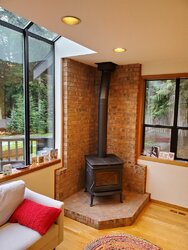So during our first cleaning(stove was installed last Jan), I noticed... our double-wall stove pipe has no screws where the bottom of the stovepipe meets the stovetop collar. It just sits there, held in place by gravity. Up top, where the uppermost 30 degree elbow meets the ceiling support box, there is just 1 screw installed there. Is that OK? Where the stovepipe meets the elbows, and each of the extendible segments, is secured in place with sets of 3 screws. So the stove pipe can't really move in normal operation, and it is pretty hard to get in and out even when I take those sets of 3 screws out. But I am worried about what happens if there is ever an earthquake while the stove is running or something like that.
Our install(from top down, ceiling support, 30 degree elbow, telescoping double wall stove pipe, 30 degree elbow, telescoping pipe, stove):

Thanks!!
Our install(from top down, ceiling support, 30 degree elbow, telescoping double wall stove pipe, 30 degree elbow, telescoping pipe, stove):

Thanks!!
Last edited:

